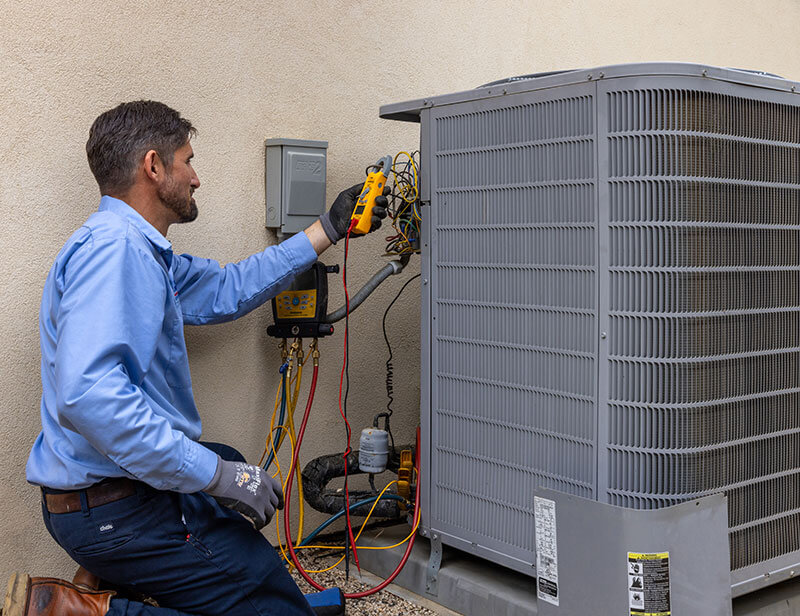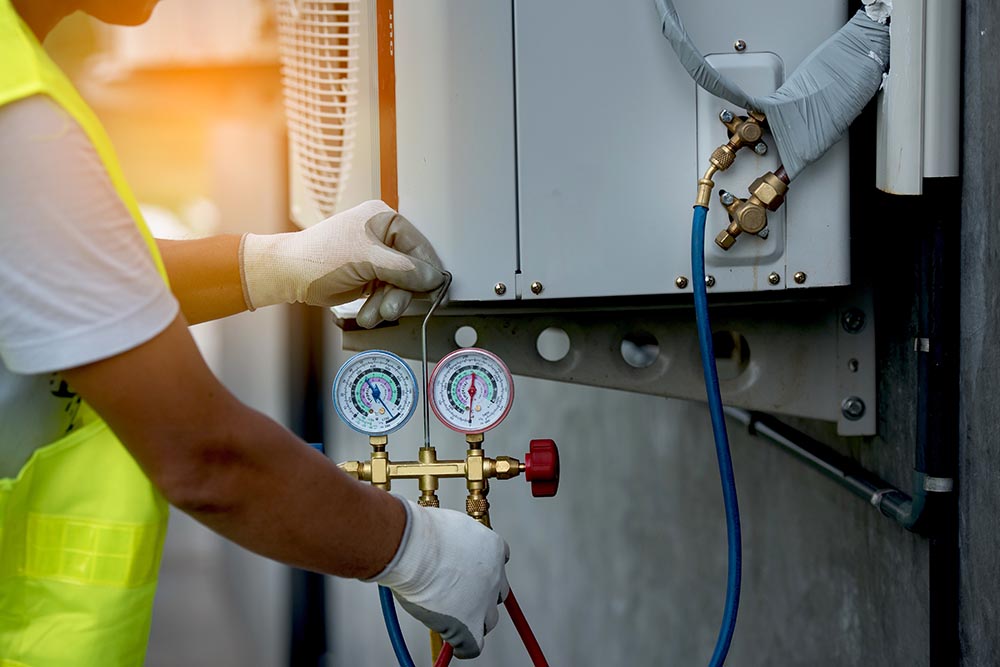Things to Know Before Your heat pump replacement ooltewah tn Starts
Things to Know Before Your heat pump replacement ooltewah tn Starts
Blog Article
How a Heat Pump and Heater Work Together to Optimize Your Home's Heating Performance
Comprehending how a heatpump and furnace collaborate is vital for home owners seeking efficient home heating options. Each system has its staminas, providing a well balanced approach to home convenience. The warm pump excels in modest temperature levels, while the heating system delivers fast warmth during extreme cold. This harmony not just decreases energy expenses yet also enhances the life expectancy of both devices. What variables affect this collaboration, and exactly how can homeowners optimize their benefits?
Recognizing Heat Pumps: Exactly How They Work
Many individuals might be strange with their inner operations, heat pumps play a necessary duty in modern home heating systems. These tools operate by transferring warm from one location to another, making use of the principles of thermodynamics. In colder months, a heat pump essences warm from the outdoors air, ground, or water, and transfers it indoors to heat the home. Conversely, during warmer months, it can turn around the procedure, acting as an a/c by removing warm from inside to the outside.Heat pumps include an evaporator, growth, compressor, and condenser shutoff. The cooling agent within the system soaks up heat as it vaporizes at reduced temperature levels and pressures. The compressor after that boosts the stress and temperature of the cooling agent, enabling it to release heat as it condenses. This reliable procedure can significantly decrease power intake contrasted to traditional home heating approaches, making warm pumps a lasting option for climate control in homes.
The Role of Furnaces in Home Heating
Furnaces play an important role in home heating by providing a reputable source of warmth throughout the cooler months. They run by producing heat via combustion or electrical resistance, distributing it throughout the home via air ducts or radiant systems. The efficiency of a heater is usually determined by its Annual Gas Use Effectiveness (AFUE) score, which indicates just how successfully the unit converts gas into heat.Furnaces can make use of different energy resources, including all-natural gas, power, oil, or lp, permitting house owners to select one of the most appropriate alternative for their needs. Unlike warmth pumps, which may battle in extreme chilly, heating systems keep consistent efficiency, ensuring that interior temperatures stay comfy no matter outdoor problems. In addition, modern heaters commonly come equipped with sophisticated modern technology, such as clever thermostats and variable-speed blowers, enhancing their effectiveness and responsiveness. This convenience makes heaters an important part in all-encompassing home heating methods.

Benefits of Making Use Of Both Solutions Together
Incorporating the toughness of both heaters and warm pumps can result in an extra reliable and reliable home heating option. Making use of both systems permits home owners to make use of the heatpump's power effectiveness throughout milder temperature levels while depending on the furnace for even more severe cold problems. This dual strategy can substantially reduce energy costs, as warmth pumps take in less electrical power than traditional home heating methods when temperatures are moderate.Additionally, using both systems with each other can enhance comfort degrees in the home. Heatpump can give constant, also heating, while furnaces can promptly increase ambient temperature levels when needed. Additionally, the assimilation of both systems can extend the life expectancy of devices by decreasing deterioration on each unit, as they share the workload. Ultimately, property owners can enjoy a balanced, cost-efficient home heating service that changes flawlessly to varying climate condition, ensuring a warm and inviting home throughout the cold weather.
Exactly How Warmth Pumps and Furnaces Complement Each Other
When homeowners integrate heatpump and heating systems, they produce a corresponding heating unit that maximizes effectiveness and comfort. Heatpump run by moving warmth from the outdoors air or ground, making them very efficient in modest environments. They excel during milder temperatures, providing cost-effective home heating. On the other hand, heating systems generate heat with combustion or electric resistance, supplying solid, prompt heat during extreme chilly conditions.The combination of these 2 systems permits for vibrant adjustments based on temperature variations. Throughout warmer months or milder winter months days, the heatpump can take the lead, preserving power and minimizing expenses. As temperature levels decrease, the heating system can seamlessly involve, guaranteeing consistent warmth throughout the home. This harmony not just enhances energy usage but likewise enhances the life-span of both systems, as each system operates within its excellent efficiency range. With each other, they produce a well balanced atmosphere that adapts to differing climate demands.
Enhancing Efficiency: Tips for Homeowners
Home owners can improve their heating effectiveness via a number of practical strategies. Developing a routine upkeep routine, incorporating smart thermostat modern technology, and carrying out effective insulation and securing services are key actions. These measures not only improve comfort yet likewise lower power prices.
Normal Upkeep Set Up
To assure optimal home heating effectiveness, developing a regular maintenance timetable is important for any kind of home. House owners must focus on routine inspections of both heat pumps and heating systems to identify peak efficiency. This consists of changing air filters every one to three months, as stopped up filters can substantially decrease effectiveness. Additionally, organizing specialist maintenance a minimum of when a year allows service technicians to recognize and address prospective issues before they intensify. Home owners should additionally clean the heat pump's outside system to avoid particles buildup that can hinder airflow. By sticking to a regular maintenance schedule, homeowners not just enhance their heating unit' efficiency yet also prolong their life expectancy, causing higher convenience and reduced energy costs throughout the cooler months.
Smart Thermostat Integration
Incorporating a clever thermostat into a home furnace can significantly improve power effectiveness, particularly as it enables specific control over temperature level news settings. These gadgets can find out the property owner's schedule and choices, automatically changing the temperature to optimize convenience while lessening power usage. They can lower heating during times when the home is empty, reducing unnecessary intake. Numerous smart thermostats likewise offer real-time energy use data, enabling homeowners to make enlightened decisions concerning their home heating routines. Furthermore, remote accessibility using mobile phone applications allows individuals to readjust settings from anywhere, making certain the home is warm upon return. On the whole, clever thermostat combination not just improves comfort yet significantly adds to energy cost savings and performance.
Insulation and Sealing Solutions
Smart thermostats play an essential function in power efficiency, however their effectiveness can be significantly boosted by correct insulation and sealing remedies. House owners need to prioritize shielding walls, floors, and attics to reduce heat loss. Premium insulation products, such as spray foam or fiberglass, can considerably boost thermal resistance. In addition, sealing gaps around windows, doors, and ducts prevents cold air infiltration and warm getaway. Weatherstripping and caulking are efficient approaches for addressing these leaks - ductless mini splits. Regular examinations for air leaks, along with making use of blower door examinations, can aid determine navigate to this website trouble locations. By investing in insulation and sealing, homeowners can optimize the efficiency of their heater, ultimately leading to reduced power intake and reduced utility expenses
Usual Myths About Warmth Pumps and Furnaces
What false impressions surround warm pumps and heating systems? Numerous individuals mistakenly think that heatpump are ineffective in cooler environments. Actually, modern-day warm pumps are designed to run effectively even in reduced temperatures, providing reputable heating throughout winter. An additional common misconception is that heaters are always extra effective than heatpump. This depends on the certain energy resources and performance ratings of the devices in question. Some may also assume that using both systems simultaneously is unnecessary, yet in reality, this combination can enhance home heating effectiveness, specifically throughout severe weather. Additionally, people often think that warm pumps require consistent upkeep, when in truth, they have similar upkeep requires to standard heating systems. By disproving these misconceptions, property owners can make even more informed decisions concerning their home heating options, ultimately bring about improved comfort and energy efficiency in their homes.
Upkeep Factors To Consider for Combined Systems

Often Asked Concerns
Can Warmth Pumps Job Properly in Incredibly Cold Climates?
Heatpump can battle in incredibly chilly environments as a result of lowered efficiency and warm removal limitations. Innovations in technology have led to designs made for far better efficiency in such problems, improving their practicality in severe settings.
Just How Lengthy Do Warm Pumps and Furnaces Commonly Last?
Heatpump usually last 15 to 20 years, while furnaces have a life-span of 15 to three decades. Normal upkeep can expand their long life, making certain reliable operation and reducing the need for early substitutes.

What Is the Average Price of Installing Both Systems?
The typical cost of setting up both a heat pump and a heating system commonly ranges in between $5,000 to $10,000 - furnace replacement. Factors influencing this expense include system dimension, installment complexity, and regional labor prices
Are There Tax Rewards for Making Use Of Energy-Efficient Heating Equipments?
Numerous home owners ask about tax obligation motivations for energy-efficient heater. Different government and state programs usually use refunds or credit scores, motivating the adoption of lasting technologies to reduce energy usage and advertise environmental responsibility.
How Do I Choose the Right Size Warmth Pump and Heater?
Picking the right size heatpump and heater includes calculating the home's square video, taking into consideration insulation top quality, and examining regional environment. Consulting a specialist can guarantee perfect system performance and energy efficiency based upon details demands. furnace replacement. Comprehending exactly how a warmth pump and heater job with each other is crucial for home owners looking for effective heating solutions. In colder months, a warmth pump essences warmth from the outside air, ground, or water, and transfers it inside your home to heat the living space. When homeowners integrate warmth pumps and furnaces, they create a complementary heating system that makes the most of performance and comfort. Warmth pumps operate by moving warm from the outside air or ground, making them very effective in moderate environments. Warm pumps can struggle in exceptionally chilly climates due to reduced performance and warm extraction constraints
Report this page